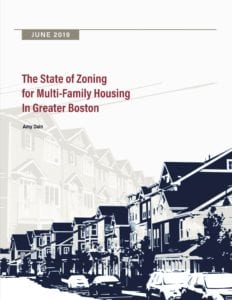Who is a member?
Our members are the local governments of Massachusetts and their elected and appointed leadership.

“The State of Zoning for Multi-Family Housing in Greater Boston” assesses zoning picture for multi-family housing in Greater Boston.
A report released yesterday provides an assessment of the state of zoning for multi-family housing in 100 cities and towns of Greater Boston, outside of Boston itself, to inform efforts at reforming the regulatory system.
The study, by researcher Amy Dain, investigated planning and zoning for the development of multi-family housing in the 100 cities and towns in the region covered by the Metropolitan Area Planning Council. The research involved a review of zoning bylaws and ordinances for the 100 cities and towns, local master plans and housing production plans in the 75 municipalities that produced plans in the last decade, and interviews with planners and several building inspectors to learn about actual building that has resulted from the zoning and planning.
The study analyzed zoning bylaws and ordinances both as barriers to limit development of multi-family housing and as vehicles to enable development.
“Zoning regulations and local plans are the output of political processes that engage both opponents and proponents of dense housing development,” the report states, “with opponents outnumbering proponents at public meetings.”
The following are some of the major findings in the 123-page report, “The State of Zoning for Multi-Family Housing in Greater Boston”:
• “The local zoning approval processes for multi-family housing have been evolving to be more flexible, political, ad hoc, unpredictable, time consuming, and discretionary. There are benefits to negotiated decision-making, but it is hard to plan for growth at the regional level with such a flexible system. Moreover, the current processes are unlikely to yield enough housing in the coming years. Policymakers could consider ways to achieve the benefits of negotiated decision-making and local control with a system that is more predictable.”
• “There has been a major shift across the region, in more than 80 percent of the municipalities, toward zoning and planning for mixed-use development, to keep historic centers vital and create new walkable hubs. The strategy has supported the development of housing in numerous town/city centers, new lifestyle shopping centers, and enclosed shopping malls. The strategy of linking the development of new housing to the development of new retail space might become problematic as demand for new retail space wanes. There may be a need to shift the strategy towards residential-only development in or near mixed use hubs and shopping centers.”
• “There has been a major movement to allow and build more housing in the region’s village centers, and there has been even more building in parcels on the edge of municipalities, isolated from residential neighborhoods. Some municipalities have been creating new village centers on the edge of municipalities, often with convenient access to highways. Municipalities have been cautious in allowing development in historic centers, typically permitting tens of dwelling units, but not hundreds. … Approximately half of the cities and towns have permitted new multi-family projects in historic centers in the last two decades. It would be useful to assess the lessons learned from building in the centers, and plan for greater development in ways that protect what residents cherish in the centers.”
• “To meet demand for multi-family housing in the region, municipalities will need to allow significant density in a small amount of land area and incremental increases in density over larger land areas. Municipalities tend to zone very little land area for the development of multi-family housing, and often the areas zoned for it are already fully built out to the capacity allowed. In theory, not a lot of land is needed to meet demand for multi-family housing, as the housing can be built upwards instead of outwards. Most municipalities highly restrict height and density of development, too, such that buildout does not satisfy demand. There are ways to allow incremental growth in residential neighborhoods while protecting the character of neighborhoods.”
The study was commissioned by the Massachusetts Smart Growth Alliance, with support from the Citizens’ Housing and Planning Association, the Home Builders and Remodelers Association of Massachusetts, the Massachusetts Association of Realtors, the Massachusetts Housing Partnership, MassHousing, and the Metropolitan Area Planning Council.
• The State of Zoning for Multi-Family Housing In Greater Boston Report – Executive Summary (12M PDF)
• The State of Zoning for Multi-Family Housing In Greater Boston – Full Report (41M PDF)